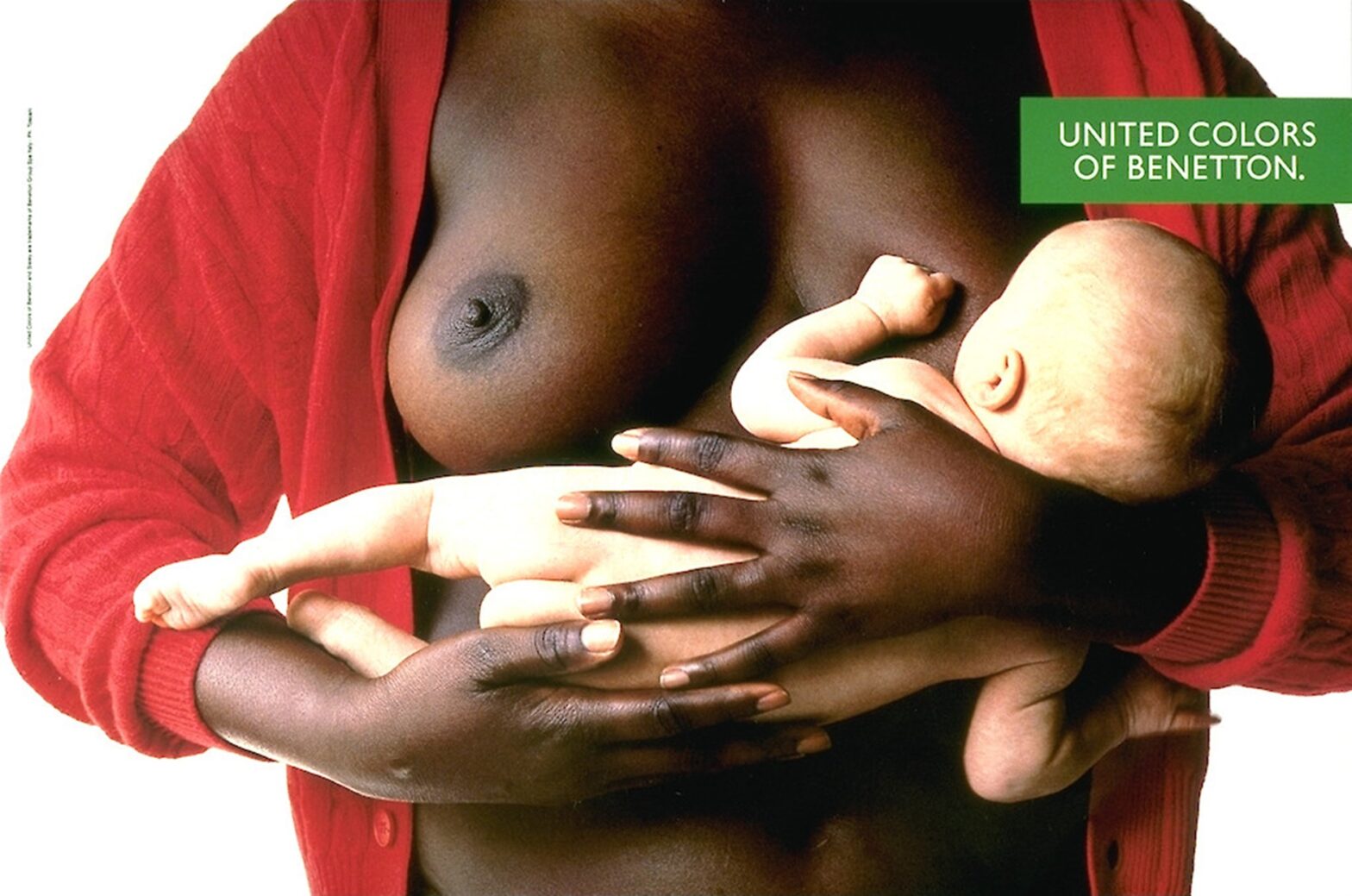Toscani was born on 28 February 1942 in Milan. He originally worked as a fashion photographer for international magazines such as Elle, Vogue and Esquire. He inherited his photographic eye from his father (Fedele Toscani was a photojournalist at one of Italy's largest newspapers, Corriere della Sera, and became famous for his photograph of the fascist dictator Mussolini, who had just been hanged in Milan's city square). We chose Toscani for this special series on notable creatives primarily because he brought a whole new approach and many controversial campaigns to the world of brand promotion. He made famous the Italian brand Benetton (United Colors of Benetton) for which he worked from 1982 to 2000.
A COLOURED WORLD ACCORDING TO A FIGHTER FOR RACIAL EQUALITY
Toscani opened up shocking topics for his time, such as racism, homosexuality, the death penalty, war and anorexia.
Racism was one of the topics Toscani focused on the most. For some, these campaigns succeeded for their novel efforts to highlight the issue. Others, however, considered these works too explicit or even downright racist. There is no doubt, however, that Toscani certainly fought AGAINST racism. In the 1990s, he founded Colors magazine, which was owned by Benetton. The subtitle was "A magazine about the rest of the world" and it was built on the idea of multiculturalism.
A campaign called Breastfeeding, which featured a black woman breastfeeding a white baby, received an intense response in the late 1980s. Those in opposition argued that the photograph might depict a black nanny breastfeeding her masters' child, thus promoting the historical problem of the systematic abuse of slaves. However, the film won awards at Cannes in France and in Italy.
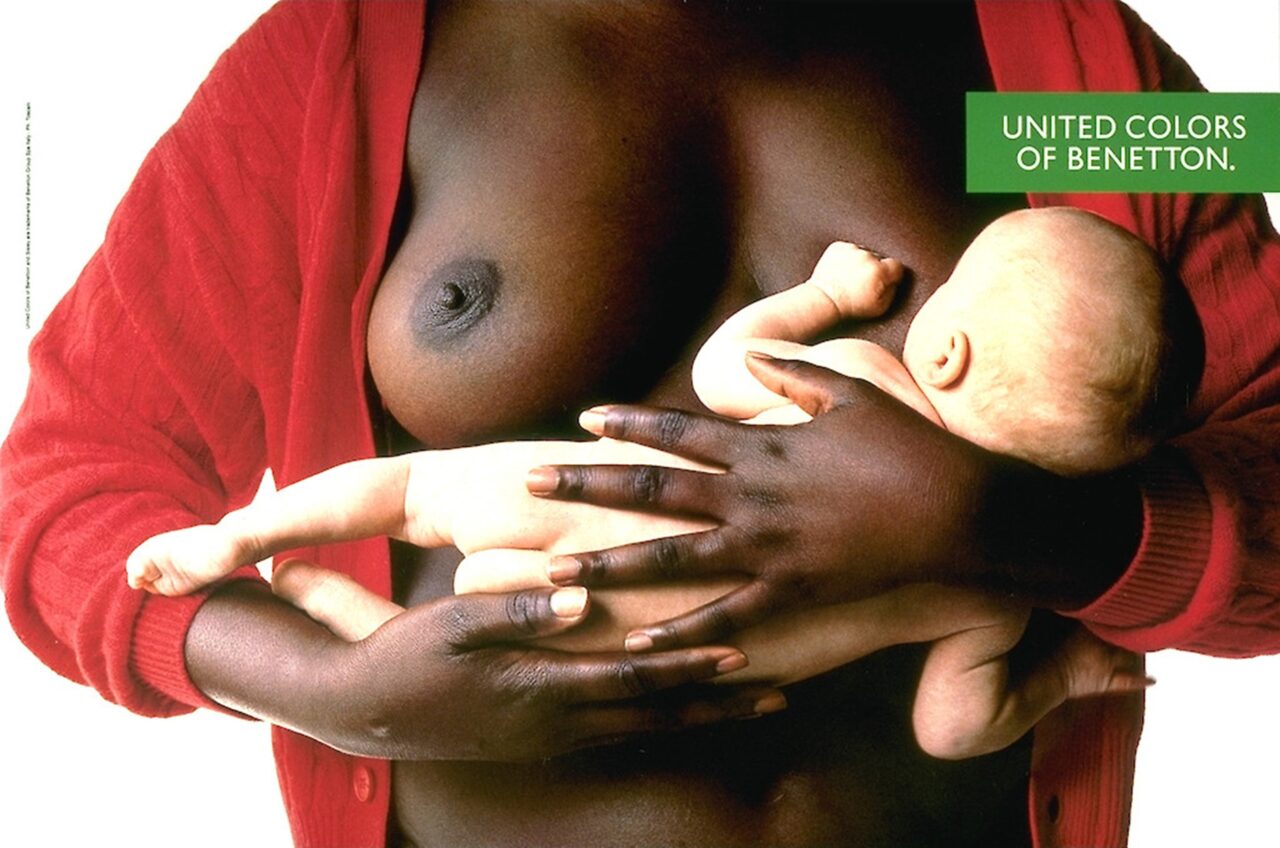 Photo: Breastfeeding campaign; United Colors of Benetto, 1989
Photo: Breastfeeding campaign; United Colors of Benetto, 1989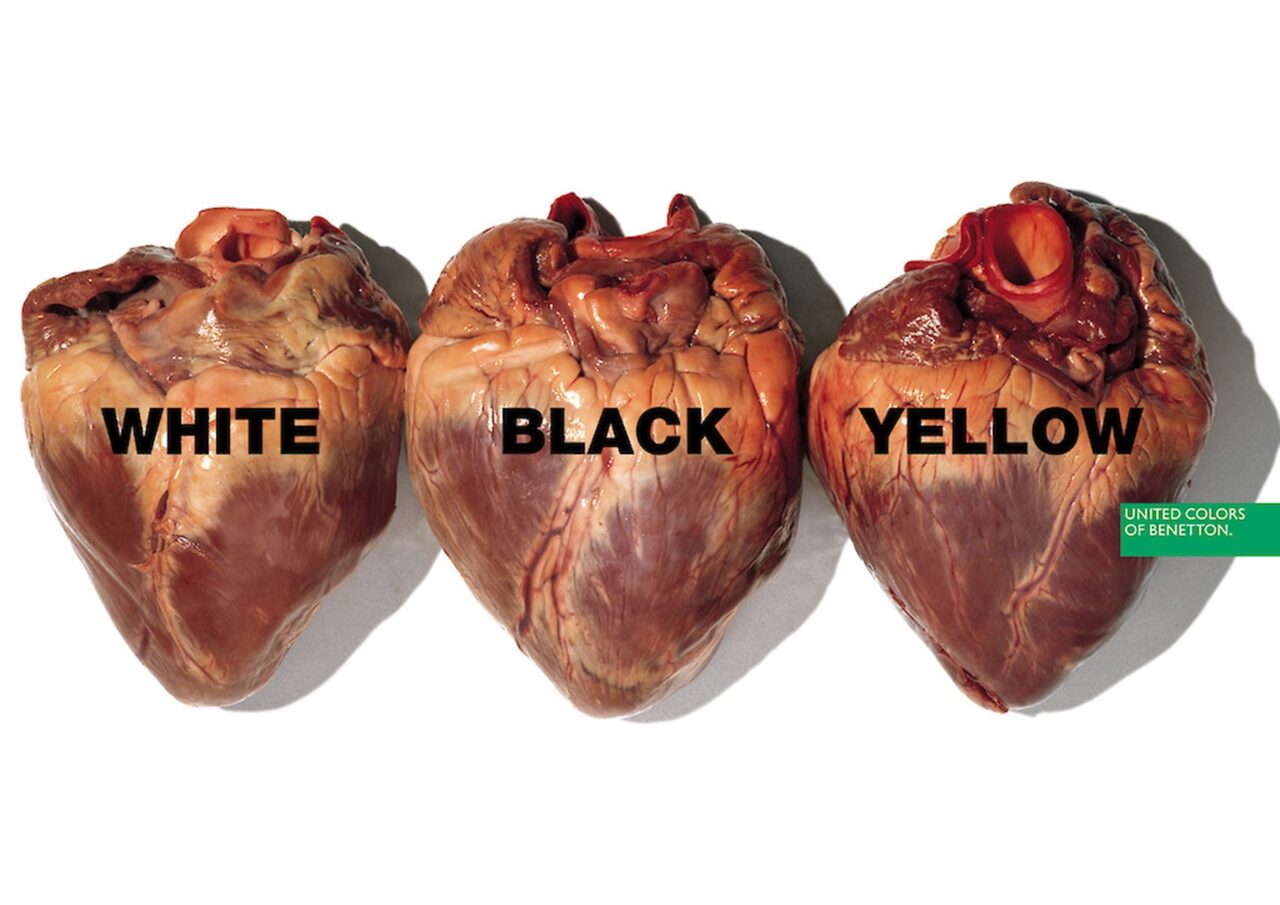 Photo: Hearts campaign; United Colors of Benetton, 1996
Photo: Hearts campaign; United Colors of Benetton, 1996Toscani then continued with the theme of racism in the Hearts campaign. The photographs of three "human" hearts with the words white, black and yellow again provoked a wave of intense reactions. After Toscani clarified that the hearts were in fact not human hearts but pig hearts, he also set the message of the work straight. "A heart is a heart," said the author, "no matter what race or nationality it belongs to.”
DOES WAR AND DEATH FIT INTO A CLOTHING AD, OR IS IT OVER THE LINE?
Toscani's most famous work is undoubtedly the portrait of David Kirby, surrounded by his family, dying of AIDS. The image was included in the book 100 Photographs That Changed the World, published by Life magazine. David Kirby agreed to let his last photograph, of him saying goodbye to his family, serve as a warning about the insidious disease.
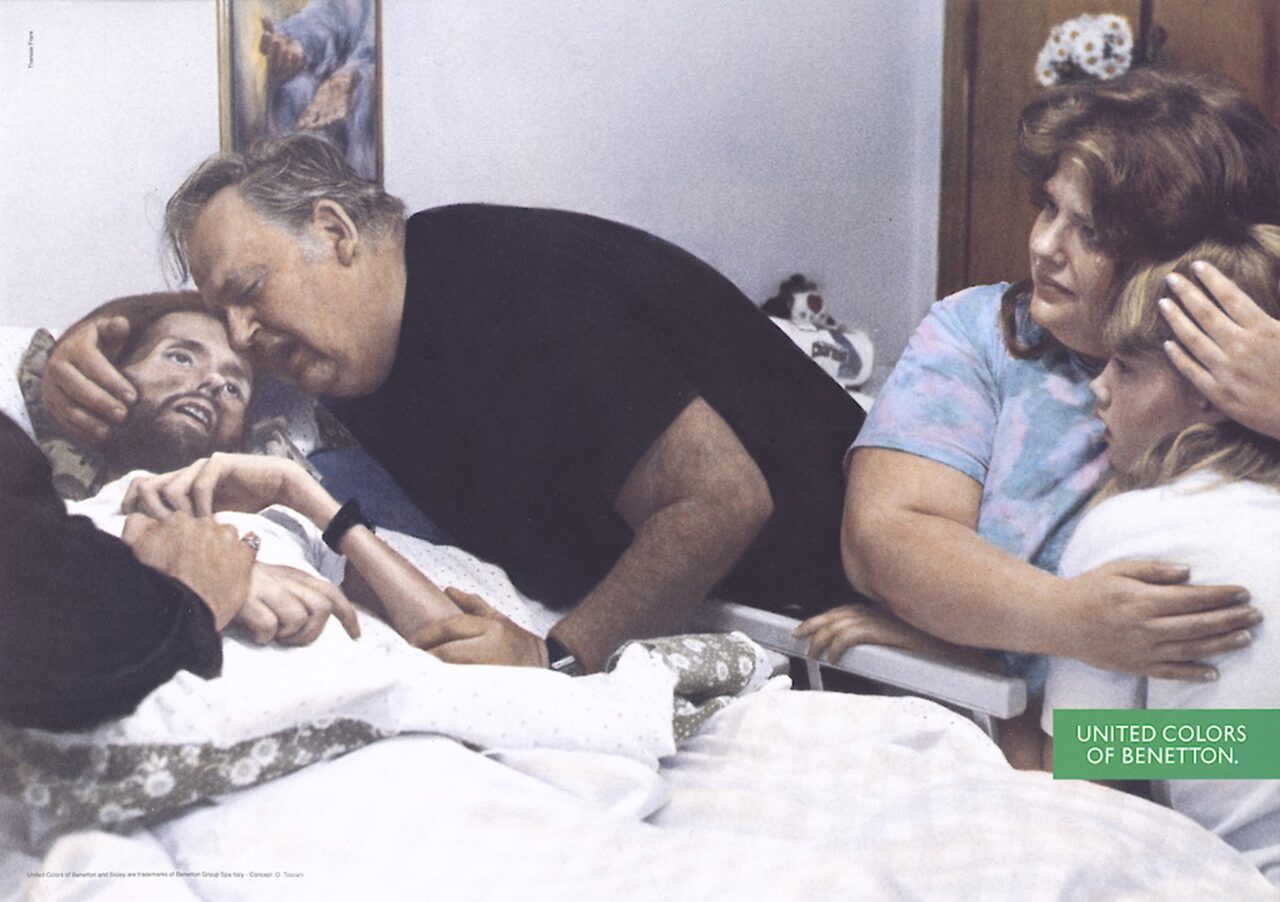 Photo: AIDS campaign; United Colors of Benetton, 1990
Photo: AIDS campaign; United Colors of Benetton, 1990Then, when war broke out in Yugoslavia in 1992, Toscani received a letter from a Sarajevo woman and mother who decided to approach him as a man whose work was visible. "Why don't you show the shamefulness of war?", she asked. And so he showed it. For in the mail, in addition to the woman's letter, he received a package containing the bloodied clothes in which her son had died in battle. The father of the fallen soldier had wished that these things would serve the cause of peace. According to Toscani, the photograph was meant to highlight the absurdity of war, but he was attacked for using death to sell the items, which understandably raised the question of ethics.
Toscani then repeated the theme of death in one of his other unorthodox subjects. He worked on the Sentenced to Death campaign for over two years, visiting death row inmates across America. Apparently, the author's main goal was to give prisoners and convicts a human face and story again. Thus, by the early millennium, these photographs were not only seen throughout the United States, but also hung on billboards in Europe and Asia.
ANOTHER CONTROVERSIAL TOPIC: ANOREXIA IN THE WORLD OF FASHION
The campaign against anorexia with the image of the skinny model Isabelle Caro also divided society into two camps. The French woman was 27 years old at the time and weighed only 31 kilograms. The intention was to draw attention to the stereotypes and pressures of the fashion world on women and girls.
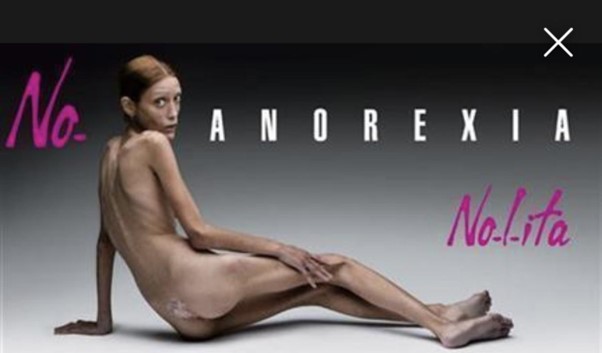 Photo: Anorexia; United Colors of Benetton, 2007
Photo: Anorexia; United Colors of Benetton, 2007"I have been dealing with the problem of anorexia for two years. Who is responsible for it?" Toscani let himself be heard, also expressing surprise and a good feeling about the fact that it was a fashion company that finally printed his picture. He appreciated that many understood the seriousness of the issue and went to the risk of publishing the controversial photos.
ADVERTISING IS A SCENTED CARCASS!
Toscani, although he himself worked in advertising, also wrote a very critical work about it. The book Advertising is a scented carcass presents the basic problems and shortcomings of the advertising world through Toscani's eyes. He talks, for example, about the waste of huge financial resources, social uselessness, deceiving the consumer, but also about the creation of false desires, the crime against creative thinking and the glorification of stupidity. Some have criticized Toscani for going against his own rules. Still, the book offers many ideas that can inspire and move any creative endeavor forward.
Benetton broke with Toscani in 2000. The reason was not the provocative nature of the campaigns, but Toscani's unfortunate comments on the tragedy in which the Morandi Bridge in Genoa collapsed. He then returned as creative director in 2017 and once again raised the topic for discussion - this time the issue of racial integration.
WHAT INSPIRATION DOES OLIVIER TOSCANI OFFER TO TODAY'S CREATIVES AND HOW HAS HIS CREATIVITY INFLUENCED TELEVISION ADVERTISING TODAY?
Oliviero Toscani has divided the world into two groups with his totally unique creations. Fans appreciate his efforts to open up burning and important topics that are less talked about than it should be. Others, on the other hand, criticise him - either for the specific ideas that have featured in his campaigns or for using serious themes to promote himself. In their view, he played on people's emotions because it is easier for us to buy an overpriced sweater if we believe it is for a good cause. They questioned the limits of the extent to which it is appropriate to profit from ethical issues.
Either way - from a marketing point of view, we cannot deny Toscani that his ads were successful, went around the world and worked like a viral - stimulating conversation about the brand, creating a 'buzz' around it and a reaction. They certainly gave the Benetton brand an absolutely unmistakable image. In his own words, Toscani believed that brands were important because they had an impact on social events and public space. He was very critical of other creatives and agencies for their uninteresting campaigns and lack of creativity.
"They are all the same because marketers are trying to please everyone. But the core of success is to listen to marketing research and then do the opposite."
Video: Integration; United Colors of Benetton (2017)
So what can we take away from Toscani's work and how can it inspire us? Make sure you are unique!
Oliviero Toscani was undoubtedly different from other creators. He brought many ideas to the world of marketing that can not only resonate today, but also inspire modern creatives. One of the reasons was that he saw his work not just as pure marketing, but as art. He was of the opinion that art has to shock in its own way, otherwise it is not art. Despite the fact that his campaigns had a distinctive feel, he himself admitted that it was from the uncertainty of the outcome that the greatest creativity came. He was often accused of not being politically correct in his campaigns. For Toscani, however, political correctness was something that destroys art.
Toscani's innovative approach to ad creation also brought new ideas to television advertising. By focusing on emotional and social messages instead of the traditional focus on product, he changed the way in which commercial messages can be effective. Ads highlighting controversial issues were highly debated and often criticized on television and in print media, but they also became icons and examples of how advertising can be a powerful tool for thought and discussion.
His work has inspired other creators in the advertising world to focus more on the emotional aspects, moving television advertising away from presenting products and towards deeper messages. Even in modern television advertising, we can see works that were prompted by these ideas and attitudes.
One example is Nike's advertising, which focuses on promoting equality and diversity. This very emotional spot also focuses on major social issues such as racism and discrimination.
The car brand Audi has also taken a similar approach. Their advertising spots are strongly focused on ecology and sustainability. This approach to brand promotion seeks to appeal to customers for whom sustainability and ecology is an important issue and makes them feel that they are doing a good deed for the planet by choosing this brand.
Toscani's ads continue to remind us how important a tool advertising is. Toscani's work can be said to have inspired a number of advertising creators and helped move TV advertising towards a greater focus on social issues and away from 'mere' product presentation. Even today, we see in the media space that this is an approach that more marketers are taking. Toscani's controversial campaigns for Benetton have become iconic and remind us that advertising can be an important tool not only to influence the perception of a particular brand or sales, but can also serve to influence and direct society.


